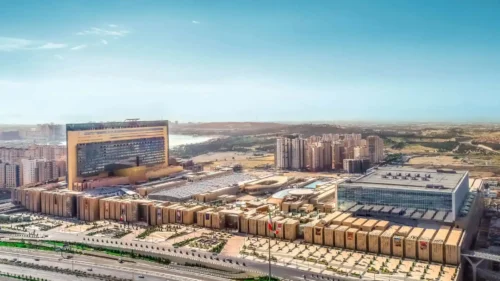
وبلاگ سپهران | Attractions | The Beautiful and Historical Mosques of Iran
Beautiful and Historic Mosques of Iran | A Legacy of Islamic Art and Architecture
The mosques of Iran are known throughout the Islamic world for some of the most intricate and exquisite architectures ever crafted by mankind. The astonishing architecture found within them cannot be fully covered in a single article.
However, we have attempted to introduce you to the beautiful and historic mosques of Iran. These places, with their unique and specific architectures and domed ceilings accompanied by tile work, provide an environment full of tranquility and beauty.
So, enabling one to enjoy the splendor of these views even more when observing the sky.
Therefore, we have decided to present various attractive types of Iranian mosques and provide a brief review of their architectural styles and history. We suggest you stay with the Sepehran blog until the end of the article.
In our religious system as Muslims, the mosque serves as a distinguished base for performing religious duties and forming social cores , holding a special and unique place. This cultural system, over the course of history and due to historical and social necessities, witnessed fundamental changes in its structure and function. It gradually transformed into a distinctive and recognizable part of Islamic civilization, with its own unique characteristics.
Iranian-Islamic architecture, at one of its most prominent peaks, has achieved astonishing structures in mosque architecture. So, some of which can be considered unparalleled in the world of religious architecture and even among various architectures based on stylistic uniqueness.
If you’re looking for a historical masterpiece, take a look at the Jameh Mosque of Yazd. This building is one of the most beautiful and extraordinary mosques in Iran, where relics from various eras have been left in every corner.
The history and construction of the Jameh Mosque began in the pre-Islamic period, and its completion dates back to the last decade.
This mosque is one of the most beautiful of the Timurid era in terms of tile work, its high portal, minarets, and inscriptions, ranking it among the most exquisite architectural masterpieces of the 9th century Hijri Qamari. Although the original building of the mosque is attributed to the period before the Timurids, the current structure, according to the existing inscriptions, shows that it was built during the Timurid era.
The inscriptions of this building, with Kufic brickwork and white Thuluth script on lapis lazuli tiles, have multiplied the beauty of this mosque. In the text of the Timurid portal and Sultan Jahan Shah’s inscription, the date 861 Hijri Qamari is read. Before Islam, the current location of the Jameh Mosque was likely the site of a Sasanian fire temple, which lasted well into the post-Islamic period.
The current structure of the mosque, with an area of about 10,000 square meters, includes an entrance portal and forecourt, a vast courtyard, side arcades of the courtyard, iwan, dome house, and lateral shabestans, a large and beautiful columned shabestan, a library, as well as historical and non-historical inscriptions and stone writings.
The orientalist Maxime Siroux believes that the first mosque, which replaced the fire temple and was known as Mosque Atiq, dates back to the early centuries of Islam.
Yazd, west side of Imam Khomeini Street, Fahadan neighborhood (location of Jameh Mosque of Yazd)
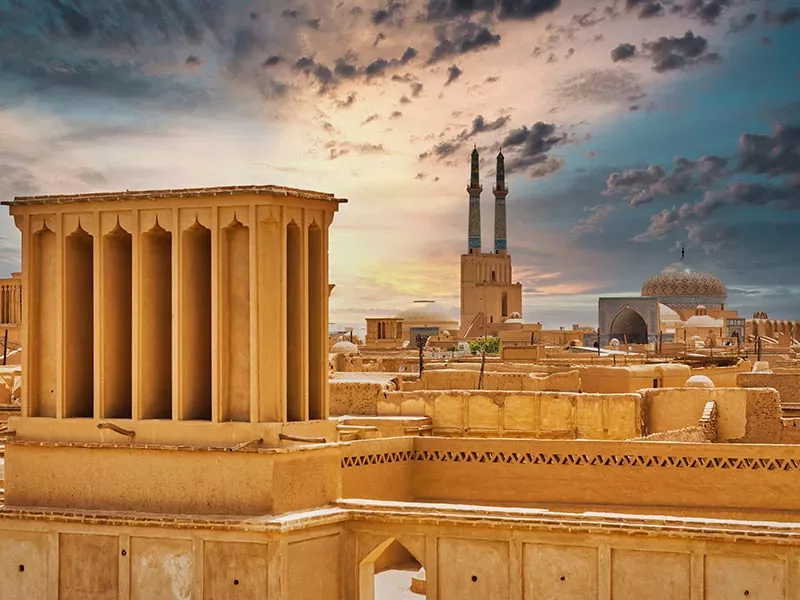
Undoubtedly, one of the most important architectural masterpieces of Islamic architecture is the Sheikh Lotfollah Mosque in Isfahan, which is considered one of the beautiful and historic mosques of Iran. This mosque was built by order of Shah Abbas the First in the year 1028 Hijri Qamari and was constructed by Master Mohammad Reza Isfahani over a period of 18 years.
The Sheikh Lotfollah Mosque is located on the eastern side of Naqsh-e Jahan Square, opposite the Aali Qapu Palace, and in close proximity to the Imam Mosque. The mosque was constructed to honor the position of Sheikh Lotfollah of Mays, where he could lead congregational prayers and teach religious sciences.
This mosque has unique characteristics, among which is the absence of minarets and shabestan, a decision made to maintain the symmetry of Naqsh-e Jahan Square. The mosque’s forecourt begins set back from the eastern edge of the square with slight architectural style differences specific to Isfahan.
Upon ascending four steps, one reaches the portal’s courtyard, which also distinguishes this mosque from other common mosques of the Safavid era. The lower parts of the courtyard walls and the large side platforms are covered with yellow marble. So, the mosque’s entrance uses solid sycamore wood in a double-door format.
Therefore inlay designs of the mosque bear the name of Ali Reza Tabrizi Abbasi as the calligrapher, who along with Baqer banna, one of the prominent but lesser-known calligraphers of that era, have adorned the portal’s inscription, lines, and other inscriptions inside the mosque with Thuluth calligraphy.
The tilework, and decorations of the dome, both inside and outside, are among the most outstanding works that the world has ever experienced.
The dome of the Sheikh Lotfollah Mosque is one of the few domes of the Safavid era whose curvature, given its short height, exerts considerable pressure on the mosque walls, which have been constructed for this purpose.
Isfahan, eastern side of Naqsh-e Jahan Square, opposite Aali Qapu Palace (location of Sheikh Lotfollah Mosque in Isfahan)
Phone number of Sheikh Lotfollah Mosque in Isfahan: 03132225486
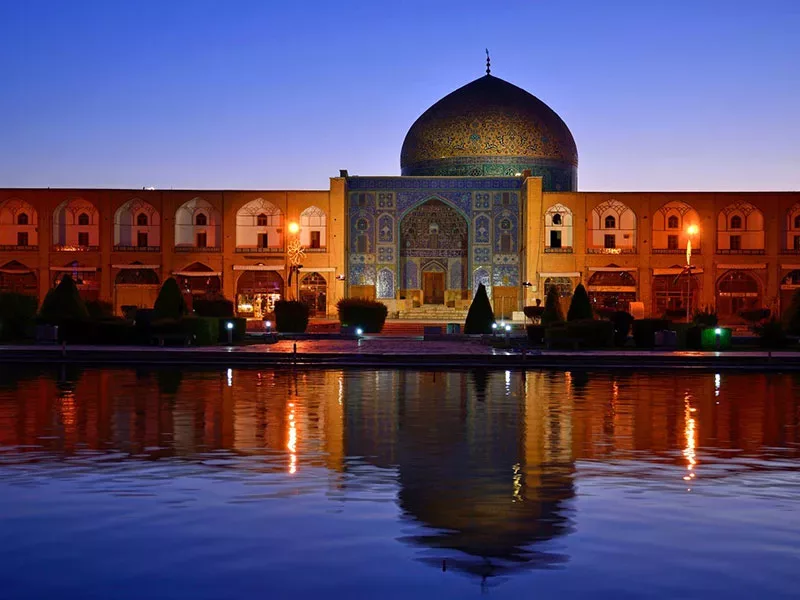
The Al-Nabi or Sultani Mosque of Qazvin, which was registered as number 122 on the list of National Monuments of Iran on December 15, 1310. This edifice is considered one of the largest historical mosques in Iran. The construction of the Al-Nabi Mosque began by the order of the founder of the Qajar dynasty, Agha Mohammad Khan, on the endowed property of Agha Jamal Vazir (Chal Vazir), and was completed during the reign of Fath Ali Shah Qajar.
However, the French traveler Jean Chardin attributed its construction to Shah Ismail I and its completion to Tahmasp I in his travelogue.
This mosque, with an area close to 14,000 square meters, features a four-iwan courtyard and a large shabestan with 28 small arches, showcasing a large stone pool at its center and connecting the two iwan sides to the octagonal arcades. Among these, the northern and southern arcades feature four-arched facades, while the eastern and western ones have nine-arched facades.
There are three entrances considered for accessing the mosque, with the northern entrance being particularly majestic and considered one of the beautiful sights of Islamic mosques. This portal is adorned with very beautiful tilework, and an inscription from lapis lazuli tiles in Nasta’liq script, which contains information about the calligrapher of the inscription, and the date of the building’s construction. The mosque’s large dome, with a diameter of 15 meters and unique tilework, is located behind the southern iwan. So, the height of its highest point from inside the building to the floor is more than 20 meters, and the height of its outer apex is around 23 meters.
In the middle of the mosque’s forecourt, there is a fountain, and the forecourt is connected to the “Sa’d al-Saltaneh” bazaar and the “Rezaee” (Shah Bath) through a covered passage.
Qazvin, southern side of Imam Khomeini Street (Rah), between Obeid Zakani Street and Saadi Street (location of Al-Nabi Mosque Qazvin)
Phone number of Al-Nabi Mosque (Sultani Mosque) Qazvin: 02833220280

One of the oldest mosques in Iran, which should also be considered the oldest mosque of Shiraz, is known as “Masjed-e Jom’e”, “Masjed al-Aqsa”, or “Jameh Atigh Mosque”. This mosque was built in the year 281 Hijri Qamari on the site of one of Shiraz’s fire temples as an expression of gratitude for the brilliant victory that Amr Leith, the second ruler of the Saffarid dynasty, had achieved in battle against the Abbasid Caliphate’s forces. The mosque was later renovated, refurbished, and expanded throughout history.
The mosque is built with two iwans and has 6 doors that are arranged on its four sides. This building also includes several chambers and shabestans and has been constructed as two stories in some parts. The northern side of the mosque has two doors on the northeast and northern axes that connect to an iwan and shabestan. The northern door, known as the “Imam’s Gate,” is considered the most significant and primary entrance to the mosque.
According to the existing inscription on the mosque, the Jameh Atigh Mosque was restored in the year 1031 Hijri Qamari by order of the reigning Safavid king. Its entrance portal was decorated with muqarnas tilework, and four inscriptions containing the names of the twelve Imams written by “Ala al-Din Jowhari” were installed on both sides of it.
In the middle of this side, there is a wide and tall arch facade adorned with a muqarnas ceiling, flanked by two tall finials. Through the entrances on this side, one can access the shabestans of the mosque. On the western side, which leads to the courtyard of the “Shah Cheragh” sanctuary, there are arcades with 10 openings. Through an entrance at the end of this side, one can access the shabestan on the southern side. Similar to the northern wall, there is a wide and tall arch facade in the middle of the southern side, which was reconstructed in 1969 due to damage.
Consequently, in this section, there is a narrow shabestan, and the structure has been elevated to two stories on both sides. On either side of the mihrab of this shabestan, which has a ceiling decorated with blue muqarnas tiles, two spiral stone columns have been constructed, and a 13-step wooden pulpit is also placed alongside it.
Shiraz, Sibouyeh Boulevard, Hazrati Street (location of the Jameh Atigh Mosque of Shiraz)

In the discussion of beautiful and historic mosques of Iran, one can mention the Blue Mosque of Tabriz. Known by names such as “Goy Masjid,” it is one of the architectural masterpieces of the Islamic period. This structure was built in the year 870 Hijri Qamari by the order of Abu’l-Muzaffar Jahanshah, son of Qara Yusuf of the Kara Koyunlu rulers, and under the supervision of his wife, “Jan Beygum Khatun”. Today, the Blue Mosque is the only remaining monument of this dynasty in their capital.
The building was severely damaged in the earthquake of the year 1193 Hijri Qamari, so much so that many parts of this structure, including the roof, walls, and minarets, were destroyed. As a result, only small parts of the original structure, which includes sections of the old mosque, have survived to this day. Among these, the remaining part of the mosque’s roof, which is adorned with gold and lapis lazuli, along with its high entrance portal and the remnants of its turquoise tilework, is a heritage that is unique in its own right.
The original complex included a collection of a school, mosque, Sufi monastery (khanqah), bathhouse, caravanserai, and library. Among these, as mentioned in the travelogue of Tavernier, the mosque was adorned with two shabestans and two eye-catching minarets.
The very high entrance portal of the mosque, with a height about twice its width, along with the highly valuable inlaid tilework that harmonizes with the brickwork of the body, has earned this edifice the title of “Turquoise of Islam,” which is considered one of the unique characteristics of this mosque.
Even today, the remaining part of this building still inspires awe and amazement and serves as a valuable testament to the calligraphic art of Master Ne’matollah al-Bawab and the tilework of Master Ezolddin-bin Malek Ghapuchi.
On both sides of the portal, and at a specific distance from it, there were two minarets with an approximate height of 32 meters that have now been completely destroyed.
The inscriptions and panels of this portal, which are executed in Thuluth and Kufic scripts, are considered one of the most complete examples of inlay from the Islamic period.
The pavement, however, is one of the few remaining parts of the original building that has remained intact and magnificent, having withstood the test of time without significant damage.
East Azerbaijan, Tabriz, Imam Khomeini Street, before Sa’at Square, next to Khaghani Park (location of the Blue Mosque of Tabriz)
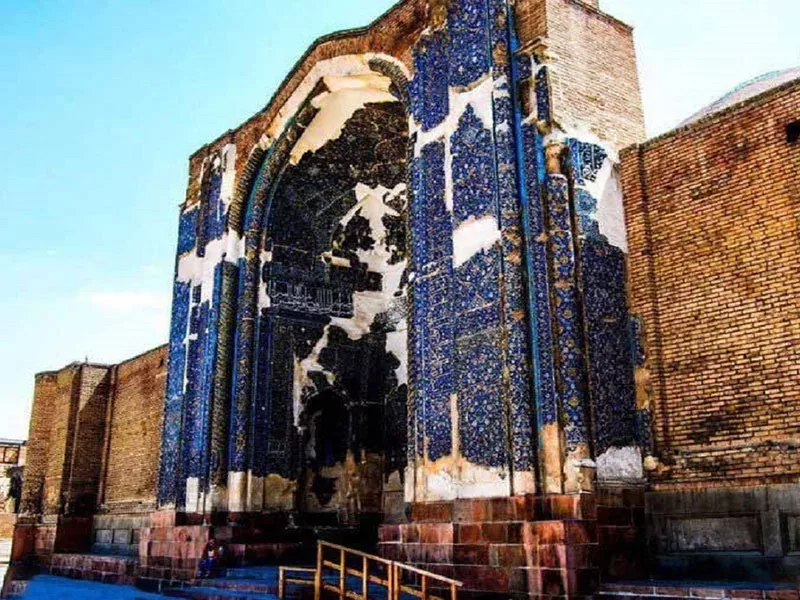
The Nasir al-Mulk Mosque of Shiraz is one of the beautiful and historic mosques of Iran, and can confidently be considered one of the most exquisite masterpieces of Iranian-Islamic architecture.
Its construction was ordered by the then governor of Shiraz, Haj Mirza Hassan Ali Khan, known as Nasir al-Mulk, in the solar year 1255 (1876 AD). The building process, supervised by Mirza Mohammad Hassan Architect, stretched over 12 years. So, the mosque covers an area of about 2,980 square meters, with 2,212 square meters dedicated to the mosque’s foundation.
Therefore, the main entrance of the mosque leads to an octagonal brick vestibule, which connects to a covered hallway turning 90 degrees to the left, leading to the mosque’s courtyard.
This mosque has two iwans, the northern one known as the “Pearl Arch,” standing at eight meters high, rightly considered the main iwan.
This is because the southern iwan lacks a specific function and was only created to symmetrize with the northern iwan. At the center of the northern iwan is the Pearl Arch, which is counted among the most magnificent tiled arches in Iran.
The Nasir al-Mulk Mosque also has two shabestans, one in the west (for summer) and another in the east (for winter). Behind the eastern shabestan, a door opens to a large well that was formerly referred to as the “Cow Well”. So, because water was drawn from the depths of the well using a strong Cow.
In this section, one can also find a small pool and a corridor. Additionally, an iwan with a width of 6 meters is located at the forecourt of the shabestan. This iwan, with 8 arches and 7 brick piers adorned with Quranic verses and floral tilework, separates the shabestan from the courtyard.
However, the western shabestan is one of the most beautiful brick shabestans of Iran’s beautiful and historic mosques. The area of the shabestan has stone columns with spiral designs. They are arranged in two rows of six in honor of the twelve Imams. Seven large doorframes decorated with stained glass connect the shabestan to the mosque’s courtyard. The sunlight passing through these glasses and reflecting on the shabestan turns this place into an admirable work of art.
This magnificent mosque was listed as number 369 in the National Heritage of Iran in February 1956, to remain as a prominent example of the art of Iranian mosque construction throughout history.
Fars, Shiraz, Lotfali Khan Zand Street, Goud-e Araban neighborhood, at the end of Nasir al-Mulk alley (location of the Nasir al-Mulk Mosque of Shiraz)
Phone number of the Nasir al-Mulk Mosque of Shiraz: 07132241661

The Agha Bozorg Mosque of Kashan is one of the masterpieces of Iranian architecture and one of the most prominent examples of Iran’s beautiful and historic mosques. This mosque is located in the heart of Kashan, in the Sultan Amir Ahmad neighborhood. The Agha Bozorg Mosque, with its unique and exclusive architecture, is also known as one of the largest, most beautiful, and holiest places of worship in the country.
Additionally, this mosque is the only five-story mosque in the world.
The mosque has four iwans, the largest and most important of which is the qibla iwan. Two minarets, approximately 48 meters in height, are situated on either side of the qibla iwan.
The Agha Bozorg Mosque of Kashan is famous for its beautiful tilework, including designs of nightingales and flowers, plants, and geometric patterns. Therefore, mihrab of the mosque is made of white marble and is beautifully decorated with plant motifs and Quranic verses.
So, the design of the mosque’s ceiling and dome, utilizing mosaic work and geometric patterns, is considered a unique example of Islamic architectural art.
This mosque is registered on the list of National Monuments of Iran and annually hosts a large number of domestic and foreign tourists.
Isfahan, Kashan, Fazel Naraghi Street, Agha Bozorg Mosque Alley (location of Agha Bozorg Mosque of Kashan)
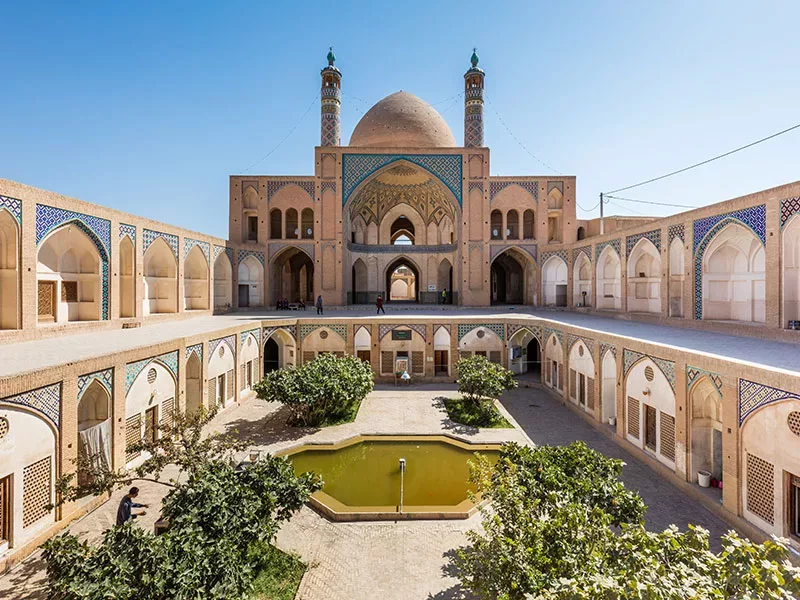
Goharshad Mosque is one of the masterpieces of art and architecture in Iran and is among the beautiful and historic mosques of Iran. This Mosque located within the holy shrine complex of Imam Reza in the sacred city of Mashhad.
So, the name of this mosque is derived from the wife of a Timurid emperor. As such, with its unique architectural and decorative features, it has become one of the most prominent examples of Timurid-era architecture in Iran.
Goharshad Mosque has four iwans, two tall minarets, one large shabestan, and several arches. The dome of the mosque, with a diameter of about 30 meters, is considered one of the largest brick domes from the Timurid period.
SO, the faience tiles with blue colors and a combination of gold, arranged on a blue background, give this mosque a unique beauty. Moreover, decorative elements featuring nightingales and flowers, Chaharbagh (four gardens), geometric patterns, and beautiful calligraphy have been used in the adornment of Goharshad Mosque.
The mihrab of Goharshad Mosque is made of marble with beautiful inlaid decorations. Furthermore, the pulpit of the mosque is also made of wood with prominent inlay work. This mosque is particularly famous for its unique designs and tilework, geometric patterns, beautiful mihrab, and the large and magnificent dome.
Khorasan Razavi, Mashhad, south of the Holy Shrine of Imam Reza (location of Goharshad Mosque of Mashhad)
Phone number of Goharshad Mosque of Mashhad: 05132232222
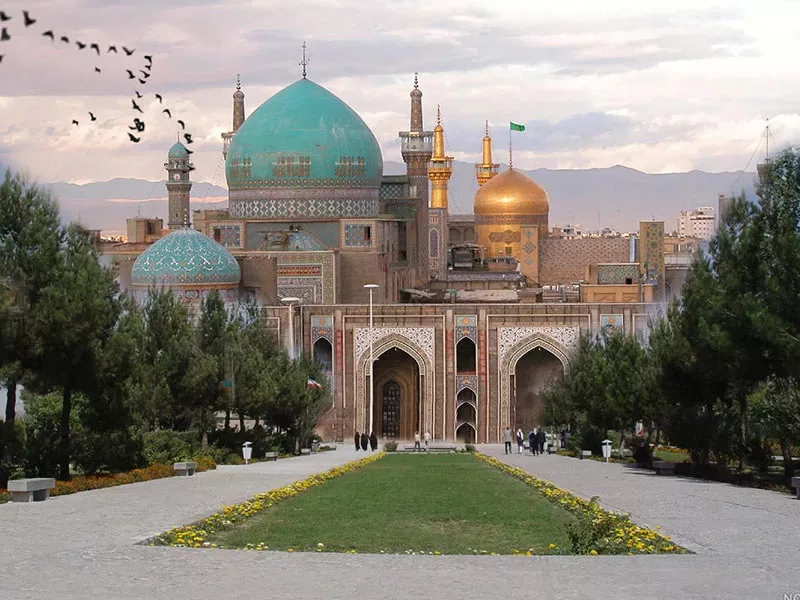
If you are looking for the most beautiful mosque in Iran, do not forget to visit the Shafei Mosque of Kermanshah. This mosque is among the religious buildings of the city of Kermanshah, located in the bazaar, and is known as one of the oldest mosques in the region. It is the most magnificent and largest mosque of the Sunni community.
The Shafei Mosque continues to be used as one of the historical and religious structures of Kermanshah and is recognized as one of the tourist attractions of the city.
The Shafei Mosque has a large iwan and a beautiful and ancient mihrab with golden minarets and magnificent columns. So, the mosque has expansive shabestans which, due to the dome and architectural design, remain cool during the summer. The architectural style used in this mosque is of the Islamic-Turkish variety.
Inside the Shafei Mosque, there are calligraphies, tile works, and various decorations, although most of these adornments have been restored over different periods.
Kermanshah, Taleghani (Javanshir) Square, Javanshir Boulevard, Tarikheh Bazaar (location of the Shafei Grand Mosque, Kermanshah)
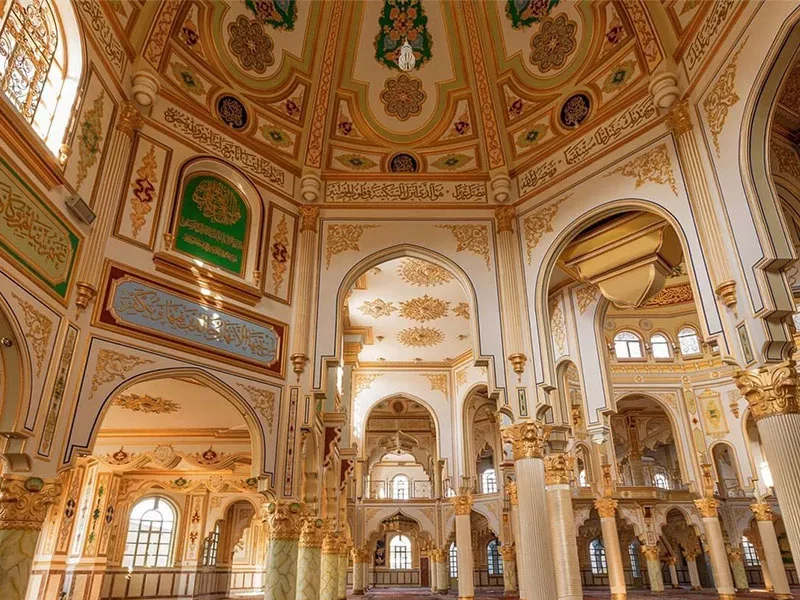
The Vakil Mosque is one of the most prominent and beautiful mosques of Shiraz and even Iran. This mosque was constructed during the Zand dynasty by Karim Khan Zand. Its name is derived from Karim Khan Zand who introduced himself as “Vakil-al-Ra’aya” or the representative of the people. The Vakil Mosque is located in the city center of Shiraz and is close to the Vakil Bazaar, one of the oldest bazaars in Shiraz.
With two large iwans, two minarets, and a large shabestan with a beautiful dome, the Vakil Mosque has become one of the masterpieces of Iranian architecture. The blue and white tilework featuring floral and geometric patterns, beautiful calligraphy, and a stone mihrab with unique designs are among the distinctive features of this mosque.
One of the most important characteristics of the Vakil Mosque is the use of traditional architectural techniques and tile mosaic work, which have made it one of the most beautiful mosques in Iran.
Due to its beauty, history, and unique geographical location, the mosque is considered one of the most important tourist attractions in Shiraz.
Fars Province, Shiraz, Taleghani Street, west of Vakil Bazaar (location of Vakil Mosque of Shiraz)
Phone number of the Vakil Mosque of Shiraz: 07132241475
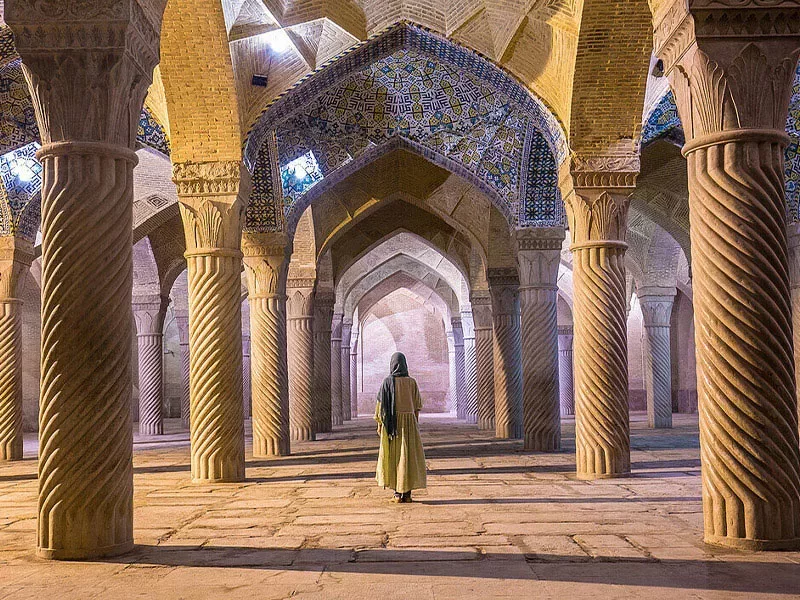
Tehran, the current capital of Iran, boasts historical and magnificent mosques, each with unique stories and characteristics. Some of the most famous and oldest mosques in Tehran include:
Located in the Tehran Bazaar, this mosque has a history as old as the city itself, with parts dating back to the Al-Buyid and Seljuk eras.
Architecture: The architecture of this mosque is a blend of different styles and has undergone numerous renovations over time. It also features extensive shabestans, beautiful mihrabs, and calligraphic inscriptions. The mosque has 5 shabestans.
This mosque was built at the end of the Qajar era by the order of Mirza Hossein Khan Sepahsalar with the cooperation of Iranian and Italian architects.
Architecture: Its architectural style is a mix of traditional Iranian and Italian Renaissance. The mosque is known for its multiple domes, tall minarets, and beautiful courtyards, which make it a valuable complex.
This mosque was built during the Qajar era by Dostali Khan Moeir al-Mamalik. Its architecture reflects the rich and prevalent style of its time. The building is located southeast of the old city center (Sangelaj neighborhood), recalling the memories of the past.
Architecture: The mosque consists of two separate parts, one rectangular and the other octagonal half-cylinder in shape. It is adorned with a dome and minarets, with brickwork used on the exterior of the mosque. No tilework is used in this mosque. An old clock tower on the north side of the mosque adds to its beauty.
This mosque was built in 1250 Solar Hijri by Sa’d al-Dowleh Haj Ghanbar Ali Khan. Ghanbar Ali Khan was a wealthy and charitable individual who endowed part of his wealth to the mosque, hence the name derived from him.
Architecture: The architecture of this mosque is designed such that, besides being a place of worship, it can also function as a windcatcher. In the past, its minarets were used for determining prayer times and observing the stars. Prominent and valuable examples of architectural art can be seen in the minarets and the main entrance of the mosque. The tilework in this building is from the Qajar era and is considered one of the most beautiful architectures of its time.
Throughout history, mosques have been regarded as places of worship for all Muslims. However, these sites also represent a significant part of the history and culture of the Iranian people. Therefore, mosques hold great importance. Each mosque has its architecture, decorations, and style, each reflecting the events of its historical period.
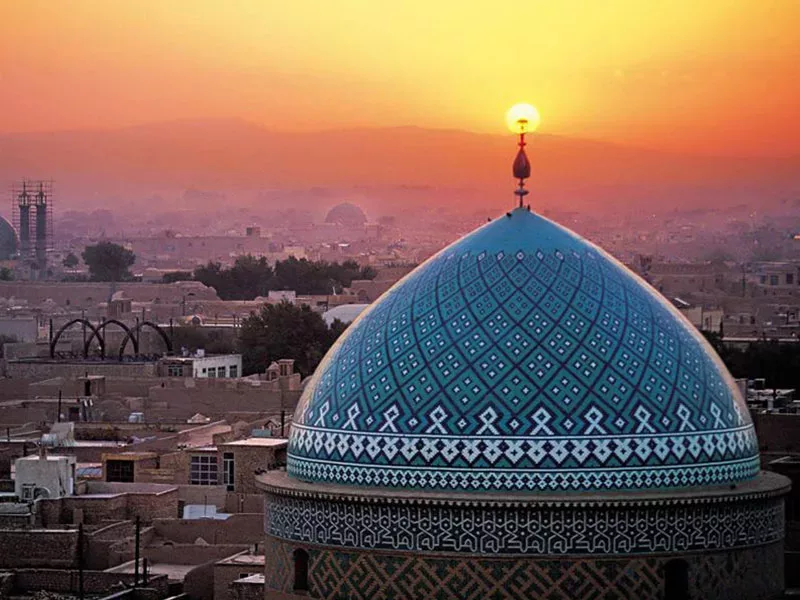
With several centuries of historical and cultural heritage in religious architecture, particularly in the construction of mosques, Iran stands as one of the prominent countries in the world. The beautiful and historic mosques of Iran are regarded not only as symbols of art and building technique but also as exemplars of culture, beliefs, and the history of the Iranian nation. These mosques, with their unique architectural features, unrivaled tilework, artistically crafted mihrabs, and distinctive minarets, have served not only as places of religious worship but also as centers for gathering, culture, and art throughout history. Overall, Iran’s historic mosques have played a significant role in promoting and preserving the cultural, artistic, and architectural heritage of the land and continue to be one of the main tourist attractions in Iran.